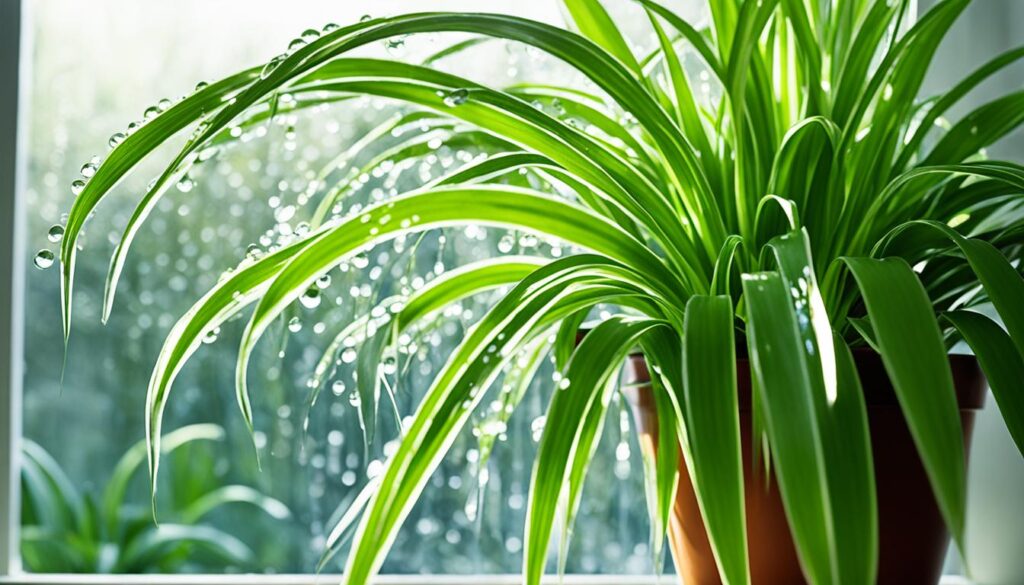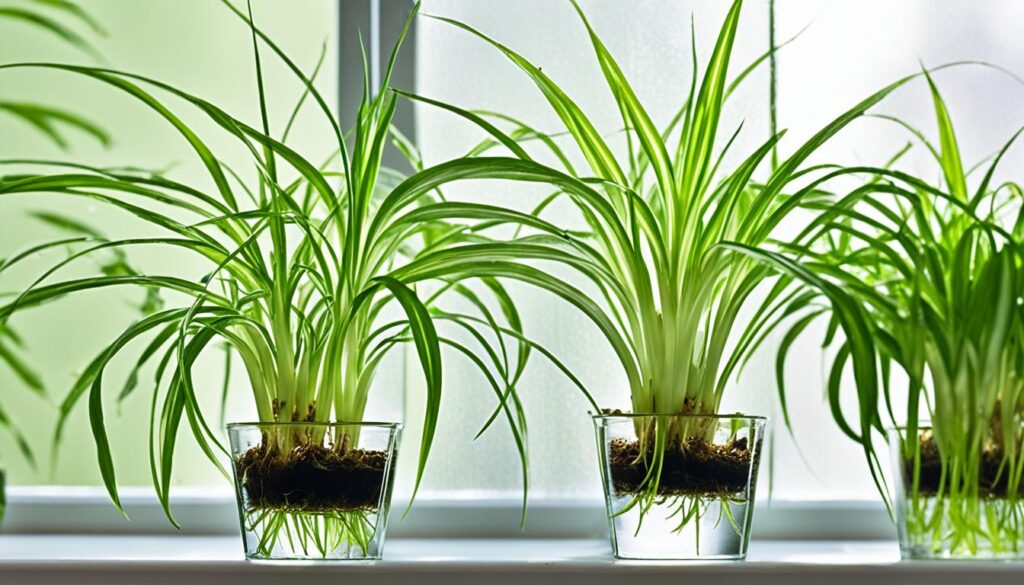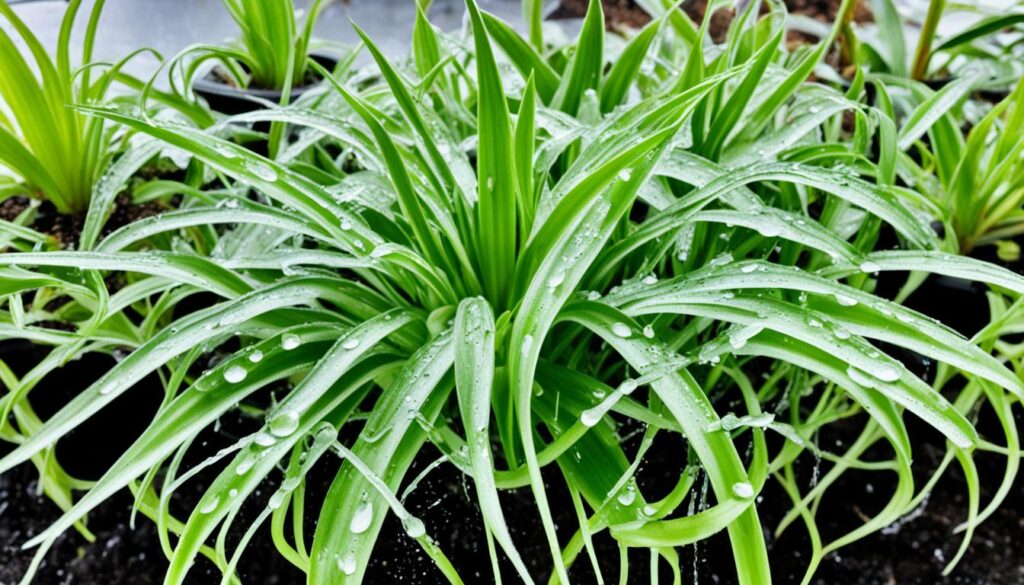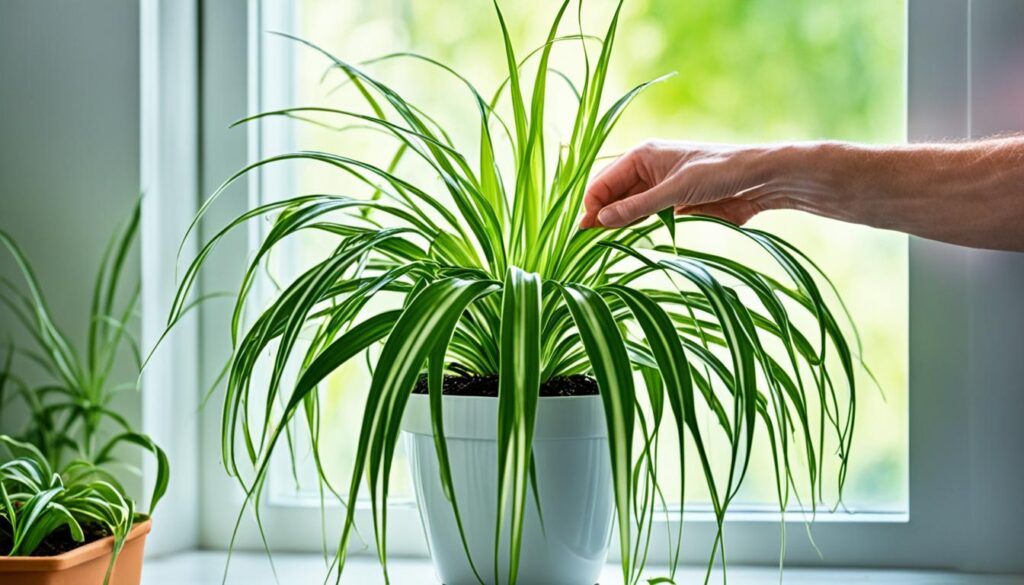I remember the day I brought home my first spider plant. It was love at first sight – the graceful leaves, vibrant green hues, and the adorable baby plants. But I quickly learned that keeping my spider plant healthy meant getting the watering right.
Spider plants, known as Chlorophytum comosum, are easy to care for and tough. Yet, finding the right watering schedule can be tricky. They don’t like too much or too little water, so finding a balance is key.
Usually, spider plants need watering once a week. But, the frequency can change with the season, temperature, plant size, humidity, and the pot and soil type. In the summer, when they grow fast, they might need water twice a week, especially for young plants. In winter, wait for the top inch or two of soil to dry out before watering again to prevent root rot.
Key Takeaways
- Spider plants usually need watering once a week, but more often in hot weather or certain potting conditions.
- Factors like season, temperature, plant size, humidity, and soil type affect watering needs.
- Too much water can cause root rot, while too little water makes leaves wilt or turn yellow.
- Regularly checking soil moisture is key to keeping your spider plant healthy.
- A soil moisture meter can help you find the best watering schedule for your spider plant.
Introduction to Spider Plants
About the Spider Plant
The spider plant, known as Chlorophytum comosum, is a favorite houseplant. It goes by many names, like airplane plant, ribbon plant, and spider ivy. These plants come from South Africa’s coasts and are loved globally.
Spider plants have thin, spiky leaves that grow in a spiral from the plant’s center. Most have leaves with a variegated pattern, showing off beautiful designs and stripes. But, you can also find solid green ones for a simpler look.
These plants are great at cleaning the air too. NASA’s Clean Air Study found they remove pollutants like carbon monoxide, benzene, and formaldehyde from indoors.
“Spider plants are one of the most common and easiest-to-grow houseplants, favored by beginners and experienced gardeners alike.”
Spider plants are easy to care for and clean the air, making them a favorite in homes and offices. They’ve been popular for over 200 years, loved by plant lovers everywhere.
Spider Plant Care Basics
Lighting Requirements
Lighting is key for spider plant care. These plants prefer bright, indirect sunlight. Too much direct sunlight can cause spider plant scorching, leading to brown spots on the leaves.
The best spot for a spider plant is in bright, indirect sunlight. Place it where it gets plenty of light but not direct sun. Offices, shelves, or near a window are good spots, avoiding direct spider plant sun exposure.
If a spider plant gets too much spider plant sunlight, its leaves may turn yellow or reddish. This means it’s stressed and needs more spider plant indirect sunlight. Right lighting helps your spider plant stay lush and vibrant.
“Spider plants are one of the most forgiving and adaptable houseplants, thriving in a variety of lighting conditions. As long as they receive bright, indirect light, they will reward you with beautiful cascading foliage.”

Watering Spider Plants
How Often to Water
Spider plants need just the right amount of water to do well. You should water your spider plant about once a week. Make sure the soil gets a bit dry before you water again. Don’t overwater, as it can cause root rot and other problems.
Watch for signs of too little or too much water. Crispy leaves mean it’s underwatered, while dark brown or mushy tips suggest overwatering. The soil should be dry up to a few inches deep before watering again. Adjust how much you water based on your plant’s needs.
- Water spider plants once a week during the growing season.
- Allow the soil to partially dry out between waterings.
- Use distilled or filtered water to prevent mineral buildup.
- Reduce watering in the winter when growth slows.
- Fertilize spider plants monthly during the growing season.
Getting the watering right is key to keeping spider plants healthy. Stick to a regular watering schedule and check the soil moisture. This way, your spider plant will get the right amount of water to flourish.
“Spider plants are resilient and can bounce back from underwatering, but they are more sensitive to overwatering, which can lead to root rot and other issues.”
Humidity and Temperature
Creating the perfect environment for your spider plant is key. Humidity and temperature are crucial for their health. Spider plants can adapt to many indoor conditions but thrive best with the right humidity and temperature.
Spider plants like a moderate humidity, between 40-80%. This keeps their leaves healthy. In most homes, the humidity is around 40-50%, perfect for spider plants. But in dry winter months, you might need a humidifier to keep the air moist.
For temperature, spider plants do well between 60°F to 80°F (15°C to 27°C). This is the usual range in many homes and offices. Avoid sudden big changes in temperature to prevent problems like leaf discoloration.
“Maintaining the ideal spider plant humidity and temperature is crucial for their overall health and vigor.”
Give your spider plant the right climate and environment for it to stay vibrant. Keep an eye on humidity and temperature and adjust as needed. This way, your spider plant will be a happy part of your indoor plants.

Soil and Potting
Choosing the right soil and potting mix is key for your spider plant. Pick a well-draining spider plant soil or mix for even moisture. Soil with perlite or similar helps keep the soil aerated. Most potting mixes are fine for spider plants.
Watch your spider plant grow fast. If it starts to droop, it might be root-bound or need a bigger pot. Repotting it every other year helps it grow well.
Feeding your spider plant with fertilizer is also key. Use standard household fertilizer and feed it once or twice a month. This keeps it healthy and strong.
Spider plants are super easy to grow, perfect for beginners, busy people, students, and anyone really.
- Miracle-Gro® Indoor Potting Mix is great for spider plants. It helps with water retention and prevents gnats.
- These plants come in solid light green and variegated dark green with a white stripe in the middle.
- They look great in hanging baskets because of their trailing plantlets.
With the right soil and mix, and regular repotting and fertilizing, your spider plant will do great. It will be a beautiful, easy plant for your indoor garden.
Common Issues and Solutions
Spider plants are known for their resilience and adaptability. However, they can face a few common issues. One of the most prevalent problems is spider plant tip burn. This issue mainly affects the plant’s looks but doesn’t harm it. To fix tip burn, just cut off the browned edges. Also, switch to pure, distilled water to prevent it from happening again.
Another issue spider plants may have is small, brown discs on the leaves. These spots are easy to remove by gently sweeping them away with your fingernail. By fixing these minor problems, you can keep your spider plant looking vibrant and lush.
Tip Burn and Discoloration
- Tip burn is a common issue, but it’s mainly a cosmetic problem that doesn’t threaten the plant’s health.
- Snip off any browned edges to improve the plant’s appearance.
- Consider using distilled water instead of tap water to prevent future tip burn.
- Small, brown discs on the leaves can be easily removed with your fingernail.
By addressing these minor spider plant problems and spider plant care issues, you can keep your spider plant looking vibrant and healthy. With a little attention, you can ensure your spider plant thrives and avoid spider plant tip burn or spider plant discoloration.

“Spider plants are easy to care for, but even the most resilient plants can face a few common issues. The key is addressing them quickly and effectively.”
Pest Control
Spider plants can face pests like mealybugs, scales, and aphids at home. These pests can easily move from one plant to another. It’s important to watch closely and act fast to keep your spider plant safe.
Using insecticidal soap or neem oil is a good way to fight pests. These products are safe for your spider plant but will kill pests. Check your plant often for pests. This way, you can stop problems before they get worse.
- Watch your spider plant for pests by looking for webs, color changes, or strange growth.
- If pests are found, use insecticidal soap or neem oil to get rid of them fast.
- Keep your plant clean and well-ventilated to prevent pests.
- Think about adding ladybugs to your plant to naturally control pests.
- Clean the leaves with a damp cloth to stop dust and debris from attracting pests.
Stay alert and take steps to prevent pests to keep your spider plant healthy. Remember, stopping pests early is the best way to keep your indoor garden safe.
Propagating Spider Plants
If you have a thriving spider plant, you can easily make more plants from it. Spider plants grow a lot and often produce “spiderettes” or baby plants. You can cut these off and root them to make new plants. This way, you can grow more or share them with friends and family.
To make a new spider plant, just take a healthy spiderette. You can either plant it in moist soil or put it in a glass of water for 1-2 weeks. After roots grow, move the baby plant to its own pot with good potting mix.
For mature spider plants, you can also divide them. Carefully take the plant out of its pot and separate the offshoots. Make sure each has its own roots. Put each section in its own pot, water them, and watch them grow into new plants.

Choose to propagate your spider plant in spring or summer, its active growing season. With patience and care, you can grow more plants. You’ll also be sharing the joy of these easy, air-purifying houseplants with others.
Air-Purifying Benefits
Spider plants are more than just easy to care for; they’re also great air purifiers. The NASA Clean Air Study found they’re natural “air scrubbers.” They can remove harmful pollutants from indoor spaces. These plants can take in and break down things like carbon monoxide, benzene, formaldehyde, and toluene. This makes them a great choice for homes and offices.
Spider plants do more than just clean the air; they also add moisture to it. This can help people with breathing problems. Some Feng Shui experts think these plants bring positive energy and balance to a space.
“Spider plants are known to purify indoor air by absorbing toxins like carbon monoxide, xylene, formaldehyde, and toluene.”
It’s true that many spider plants would be needed to make a big difference in air quality. But, these plants are tough and don’t need much care. They’re a natural way to make the air we breathe indoors better.
If you want to improve the air quality in your home or office, the spider plant is a great pick. It’s good for the air, tough, and easy to take care of. This plant is sure to be a welcome addition to any space.
Difficulty Level
Spider plants are easy to care for, making them perfect for beginners or those new to plant care. They have a low spider plant care difficulty rating. This means they are easy to take care of and can even grow well in tough conditions.
These plants have simple spider plant maintenance needs. They can live in a variety of lighting, from bright light to partial shade. And, they’re forgiving if you forget to water them sometimes.
As spider plant beginner plants, they’re tough and can recover from small mistakes. This includes forgetting to water them or watering too much.
- Water spider plants when the top 50% of the soil feels dry.
- Too much water can cause root rot, so let the soil dry out between waterings.
- Don’t shock the plant by cutting off more than 20% of dead leaves.
- Regular watering and bright, indirect light help prevent wilting or drooping leaves.
Spider plants also like a wide temperature range, usually between 70°-90° F. They can even handle cooler temperatures without much trouble. Their spider plant care difficulty is lowered by their ability to grow in different soils. Just make sure the soil drains well and has organic matter in it.

With their toughness, flexibility, and easy care, spider plants are great for both spider plant beginner plant owners and seasoned gardeners. They’re a smart choice for anyone wanting a low-maintenance indoor plant.
Caring for Spider Plants
Caring for a spider plant is easy and rewarding. These plants need little upkeep, making them perfect for both new and seasoned gardeners. By focusing on your spider plant’s needs and making a few simple changes, you can help it flourish. This will add a lovely touch of green to your home.
To begin, check the soil moisture of your spider plant and water it when the top inch or two feels dry. Don’t overwater, as this can cause root rot and other problems. Also, consider spider plant fertilizing during the growing season. Just follow the fertilizer instructions and apply it once or twice a month.
If your spider plant looks droopy, it might be time for a spider plant repotting. This is usually needed every other year or so, as the plant can get root-bound and outgrow its pot. When you repot it, move it to a slightly larger container with soil that drains well. This gives the plant the room it needs to grow well.
- Regularly check the soil moisture and water your spider plant when the top inch or two feels dry.
- Fertilize your spider plant during the growing season (spring and summer) to help it grow strong.
- Repot your spider plant every other year to stop it from becoming root-bound.
- Trim away any damaged or dead leaves to keep your plant looking neat and attractive.
By following these spider plant care tips, you can enjoy the beauty and air-purifying benefits of these versatile houseplants for many years. Remember, the key to successful spider plant maintenance is paying attention to your plant and making simple adjustments as needed.
“Spider plants are a remarkably low-maintenance choice that can thrive with minimal effort, making them an ideal option for busy individuals or those new to plant care.”
Conclusion
Spider plants are loved for many reasons. They stand out with their unique, spiky look. They don’t need much care but add beauty to any spot. You can find them in many places, from big stores to online shops.
These plants are great for both new and experienced plant lovers. They clean the air and are easy to take care of. This makes them a top choice for anyone looking for a good houseplant.
The spider plant is versatile and easy to keep up with. It’s great for cleaning the air and is popular in homes and offices. To keep it happy, make sure it gets the right amount of water, light, and soil.
For anyone into plants or just starting, the spider plant is a great pick. It makes any space look better with its beautiful leaves. Plus, it’s good for the air and easy to care for. It’s why so many people in the U.S. love having spider plants at home.


